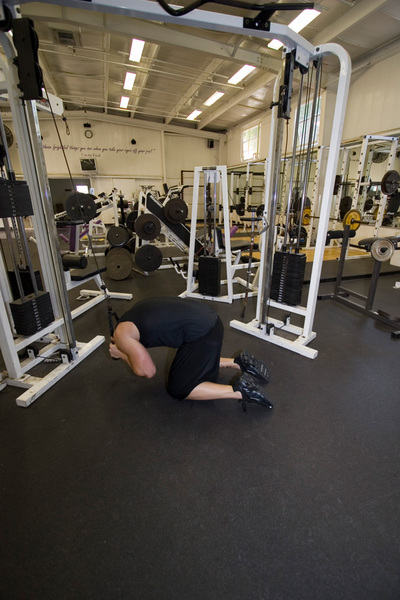Lose the Flab
Mar 14, 2011

How to lose that unsightly belly fat once and for all.
How to Lose Belly Fat
from wikiHow - The How to Manual That You Can Edit
There are a lot of gimmicks and infomercials around about how to get rid of that pesky, unflattering belly fat. If done properly, weight loss doesn't have to be the hell most people believe it to be, you may in fact feel better during a proper diet regimen. While there's no "magic bullet" that will target abdominal fat in particular, this article will explain what causes an expanding waistline, and how you can make the extra baggage go away.
Steps
- Exercise for weight loss. Aerobic exercise will facilitate fat loss all over your body, including your belly. You can't "spot-burn" belly fat, but it's usually the first to burn off when you exercise, regardless of your body shape or size.[1][2] Just be sure that you focus on calorie-burning exercises, rather than sit-ups or crunches. If your abdominal muscles are covered in fat, no strengthening of those muscles is going to change that. Aerobic exercise is key.[1]
- Add resistance training. A 2006 study published in the International Journal of Sport Nutrition and Exercise Metabolism suggests that combining cardiovascular (aerobic) exercise with resistance training is more effective than cardiovascular training alone in getting rid of abdominal fat[3] You can do resistance training with free weights, exercise machines, or resistance bands.
- Reduce your calorie consumption, and swap out certain foods for others. Unless you restrict your calorie intake, you're not going to lose belly fat. There are some tactics that might help do away with belly fat faster, but only when you've already consistently restricted your calorie intake. For example, eating an avocado after eating an entire bag of chips isn't going to help you get rid of belly fat--in fact, it'll probably make the problem worse! By reducing your daily calorie intake to 500 calories below your maintenance level you can expect to loose around 1 pound per week. It is not recommended that your daily calorie deficit exceed 500, and never consume less than 1,100 calories / day. Always consult a physician before starting any diet plan.
- The key point here is that a real diet does not involve removing or drastically reducing your intake of calories, there should only be a slight reduction. If you do not get out of hand when reducing your caloric intake, weight loss should not be incredibly painful. It's much easier to maintain a slow, gradual loss of weight than attempting to lose lots in a short period of time.
- Switch out refined grains for whole grains. In a scientific study, people who ate all whole grains (in addition to five servings of fruits and vegetables, three servings of low-fat dairy, and two servings of lean meat, fish, or poultry) lost more belly fat than another group that ate the same diet, but with all refined grains. A diet rich in whole grains changes the glucose and insulin response in your body, which hastens the melting of fat, and visceral fat, that deep layer of fat, is easier for your body to burn than the subcutaneous fat under your skin (the fat that you can see and grab).[1]
- Eat the better fats. Studies suggests that a diet with a higher ratio of monounsaturated fats (MUFAs) (avocados, nuts, seeds, soybeans, chocolate) can prevent the accumulation of both types of belly fat.[4] Some experts argue, though, that it's not that these fats specifically target abdominal fat in any way; it's that anyone will probably lose weight on a lower calorie diet (regardless of where those calories come from) and as discussed earlier, belly fat is usually the first to go.[1]
- Trans fats (in margarines, crackers, cookies--anything made with partially hydrogenated oils) seem to result in more fat being deposited in the abdomen, so avoid these as much as you can.[5]
- Get more fiber in your diet. Soluble fiber (apples, oats, cherries) lowers insulin levels, which, as mentioned earlier, can speed up the burning of visceral belly fat.[5]
- Add fiber to your diet slowly. If you are currently getting 10 grams of fiber a day, don't jump to 35 grams of fiber the next day. You need to give the natural bacteria in your digestive system time to adapt to your new fiber intake.
- Leave the skin on! Incorporating more fruits and vegetables into your diet will add fiber, but only if you eat the skin, because that's where all the fiber is. So don't peel those apples before you eat them. If you're eating potatoes, try to leave the skin in the dish (such as if making baked or mashed potatoes) or if you peel them, make a snack out of them, such as baked garlic Parmesan peels. It's also worth knowing that keeping the skin on potatoes when you cook them will help keep more vitamins and minerals in the flesh. Just don't eat any parts of skin that are green.
- Eat more split pea soup. Split peas is a fiber "power food". Just one cup of them contains 16.3 grams of protein!
- Motivate yourself by understanding the risks associated with belly fat. Losing belly fat doesn't have to be solely a cosmetic goal; understanding the health issues linked with belly fat can help motivate you. Belly fat is linked with cardiovascular disease, diabetes, and cancer. Specifically it's the deepest layer of belly fat--the fat you can't see or grab--that poses health risks. That's because these "visceral" fat cells actually produce hormones and other substances that can affect your health (e.g. increased insulin resistance and/or breast cancer risk).[2] The fact that they're located right next to and in between organs in your abdominal cavity doesn't help. For example, fat next to the liver drains into it, causing a fatty liver, which is a risk factor for insulin resistance, setting the stage for Type 2 diabetes.[6]
Tips
- An additional benefit to exercising is that it reduces stress and insulin levels, which reduces the presence of cortisol, a hormone that leads to more belly fat deposits.[5]
- Since cortisol leads to more belly fat, and cortisol is linked with stress, anything you can do to cut stress in your life will also indirectly cut (or at least prevent more) belly fat.
- The way your body distributes fat is largely beyond control (heredity, menopause). What is within your control is your level of body fat overall--if you keep that low, it won't really matter where the fat goes, because there won't be much fat to deposit in the first place.
- Many women start gaining more weight in their belly as they get older, especially after menopause. The body fat distribution changes--less fat goes to your arms, legs and hips, and more of it goes to your midsection. Some people even find their waistline widening while their weight remains the same![2] Nonetheless, the above steps will help to do away with belly fat.
- If you don't have weights for resistance training, you can by lifting anything heavy (with care!) or you can use gravity as resistance: Do pull ups and push ups.
- If you're having trouble getting motivated to exercise, get halfway there. If you want to go to the gym, but just don't feel like it, at least just drive yourself to gym, and tell yourself that if you still don't feel like working out, you'll go home. Odds are, though, once you're there, you won't feel like driving home. (But if you do, that's OK too. But you probably won't.) Then tell yourself you'll just walk on the treadmill for 10 minutes, even if your exercise routine involves much more. Just telling yourself to do one more thing, without having to commit to anything else, will make things much easier. And before long, your endorphins will take over.
- An easy way to burn more fat is to walk everywhere within a reasonable distance. You save money on gas, and also save wear and tear on your vehicle. And you might save parking charges and/or cab, bus or subway fares. All you need are comfortable shoes (take your dressier shoes with you if necessary) and walk, walk, walk. Pick up the pace as you get fitter to make those short journeys even quicker and smile at all the traffic traveling bumper to bumper in the rush hour.
- Eat smaller dinners. Large dinners tend to hurt a fat loss process because most people aren't very active after dinner. This is the basis for advice along the lines of "don't eat anything within a certain number of hours before going to bed". The claim that your entire dinner is stored as fat isn't entirely true. The process is more complicated than that, but the fact you don't move after dinner is enough to hurt your cause. You can offset this by eating a larger lunch or snacking healthily before dinner.
- If you get lots of sweet cravings, replace sweets and sugar with fruits. The sugars in fruits are digested differently than the empty calories of white sugar that are in most candy and processed foods. The fiber in fruit also slows the absorption of the sugars so you don't get as high a sugar rush (and as low a crash).
- At times, for lack of anything better to do, some people snack. This is usually due to a craving, rather than hunger. When you find yourself wandering for food, try to do something that's not food-related to hold your attention.
Warnings
- Doing only sit-ups and crunches can actually cause the appearance of more belly fat, as the abdominal muscles grow in size and shape, they will push out against the fat, making it appear larger and thicker.
- If you've lost weight or been pregnant, you may have excess skin in the belly area that won't disappear no matter how much fat you burn. You will only know how much excess skin there is, though, if you get rid of all the fat first. It is also possible that your skin will tighten up again once you've lost the belly fat.
Related wikiHows
- How to Start Your Own Exercise Regimen and Stick to It
- How to Lose Weight
- How to Get Six Pack Abs
- How to Be Healthy
- How to Exercise While Watching TV
- How to Have a Healthy Nutritional Balanced Diet
- How to Start Walking for Exercise
- How to Burn Fat on Men
Sources and Citations
- ↑ 1.0 1.1 1.2 1.3 1.4 http://www.webmd.com/diet/features/the-truth-about-belly-fat
- ↑ 2.0 2.1 2.2 2.3 http://www.mayoclinic.com/health/belly-fat/WO00128
- ↑ http://www.ncbi.nlm.nih.gov/pubmed/17136940
- ↑ http://health.msn.com/weight-loss/articlepage.aspx?cp-documentid=100185417
- ↑ 5.0 5.1 5.2 http://www.newsweek.com/id/168129/page/2
- ↑ 6.0 6.1 http://www.npr.org/templates/story/story.php?storyId=96922213
Article provided by wikiHow, a wiki how-to manual. Please edit this article and find author credits at the original wikiHow article on How to Lose Belly Fat. All content on wikiHow can be shared under a Creative Commons license.






